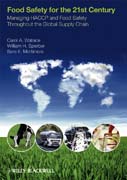
Food safety for the 21st century: managing HACCP and food safety throughout the global supply chain
Wallace, Carol
Sperber, William
Mortimore, Sara E.
INDICE: Preface. Acknowledgements. Disclaimer. How to use this book. The authors. Glossary of terms and acronyms. PART ONE: FOOD SAFETY CHALLENGES IN THE21ST CENTURY. 1 Origin and evolution of the modern system of food safety management: HACCP and prerequisite programmes. 1.1 Historical perspectives. 1.2 Origin and evolution of HACCP. 1.3 The necessity of prerequisite programmes. 1.4The future of HACCP. 2 Lessons learned from food safety successes and failures. 2.1 Introduction. 2.2 Benefits of using HACCP lessons learned from successful implementation. 2.3 Misconceptions or failure to understand HACCP. 2.4 Barriers to effective HACCP use. 2.5 Reasons for failure. 2.6 Difficulties with applying HACCP through the entire food supply chain. 2.7 Roles and responsibilities lessons learned. 2.8 Conclusions. 3 Food safety challenges in the global supply chain. 3.1 Introduction. 3.2 Increased complexity of the global supply chain. 3.3 Food safety issues in global trade. 3.4 Strategic-level responses. 3.5 Tactical level responses. 3.6 Conclusions. 4 The future of food safety and HACCP in a changing world. 4.1 Introduction. 4.2 Food safety issues. 4.3 Technology advancements. 4.4 Food safety management. 4.5 Changes in thinking/policymaking. 4.6 Conclusions. PART TWO: FOODBORNE HAZARDS AND THEIR CONTROL. 5 Recognising food safety hazards. 5.1 Introduction. 5.2 Biological hazards. 5.3 Chemical hazards. 5.4 Physical hazards. 5.5 Conclusions. 6 Designing safety intoa food product. 6.1 Introduction. 6.2 Formulation intrinsic control factors. 6.3 Use of experimental design and analysis. 6.4 Ingredient considerations. 6.5 Conclusions. 7 Designing a safe food process. 7.1 Introduction. 7.2 Process control of microbiological hazards. 7.3 Process control of chemical hazards. 7.4 Process control of physical hazards. 7.5 Conclusion. PART THREE: SYSTEMATICFOOD SAFETY MANAGEMENT. 8 Overview of a world-class food safety programme. 8.1 Introduction. 8.2 Preliminary concepts and definitions. 8.3 World-class foodsafety programmes in the global food supply chain. 8.4 Continuous improvementof the world-class food safety programme. 8.5 Conclusions. 9 Building the foundations of a world-class food safety management programme: essential steps and practices. 9.1 Introduction. 9.2 Essential management practices. 9.3 Preparation activities for food safety programmes. 9.4 Prioritisation of corrective actions. 9.5 Conclusions. 10 Formalised prerequisite programmes in practice. 10.1 Introduction. 10.2 Prerequisite definitions and standards. 10.3 Prerequisite programmes the essentials. 10.4 Prerequisite programmes and operational prerequisites. 10.5 Validation and verification of prerequisite programmes. 10.6 Conclusions. 11 Conducting a product safety assessment. 11.1 Introduction. 11.2Training for research and development personnel
- ISBN: 978-1-4051-8911-8
- Editorial: Wiley-Blackwell
- Encuadernacion: Cartoné
- Páginas: 352
- Fecha Publicación: 26/11/2010
- Nº Volúmenes: 1
- Idioma: Inglés
